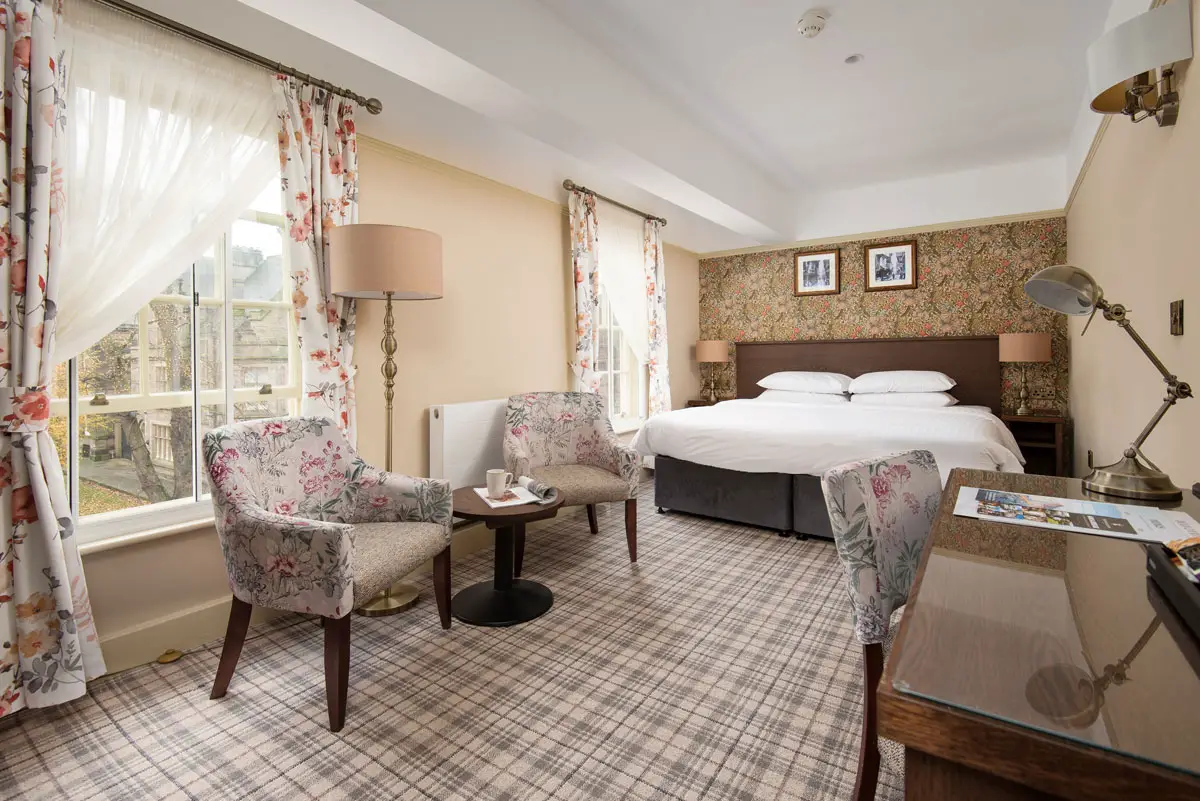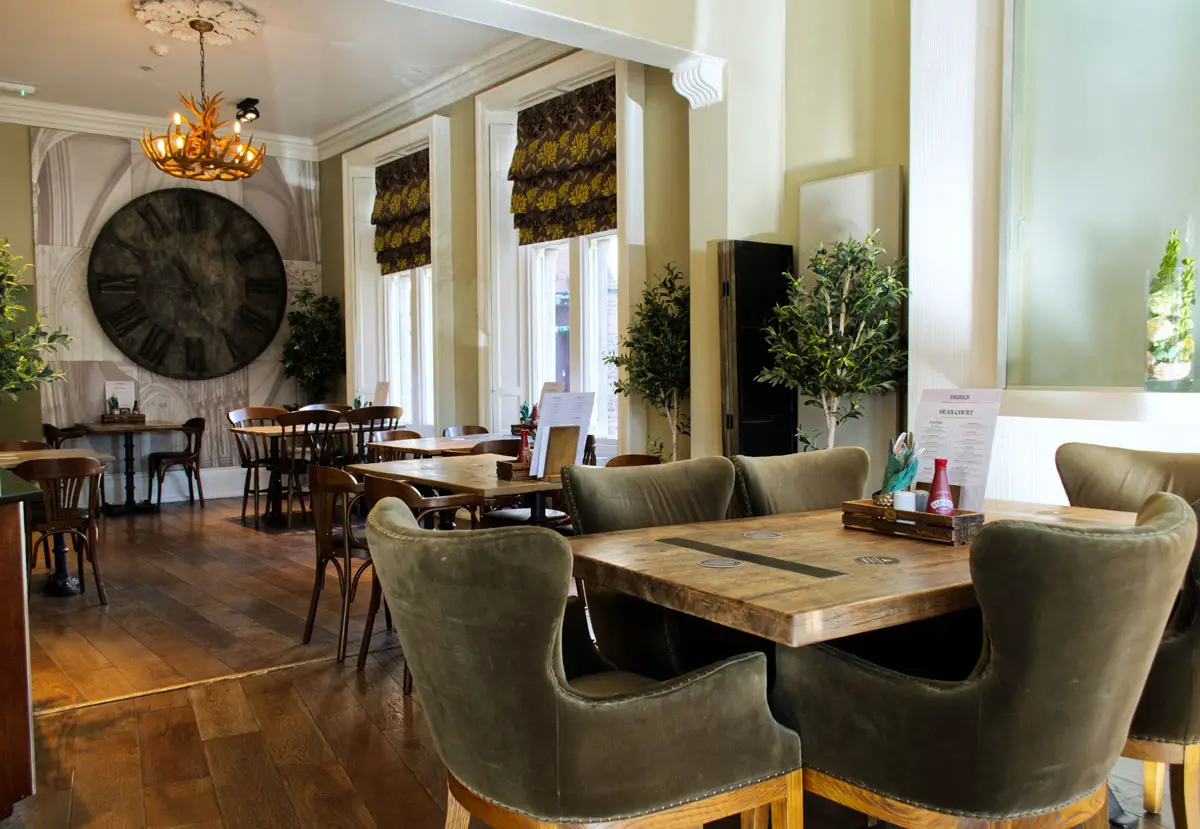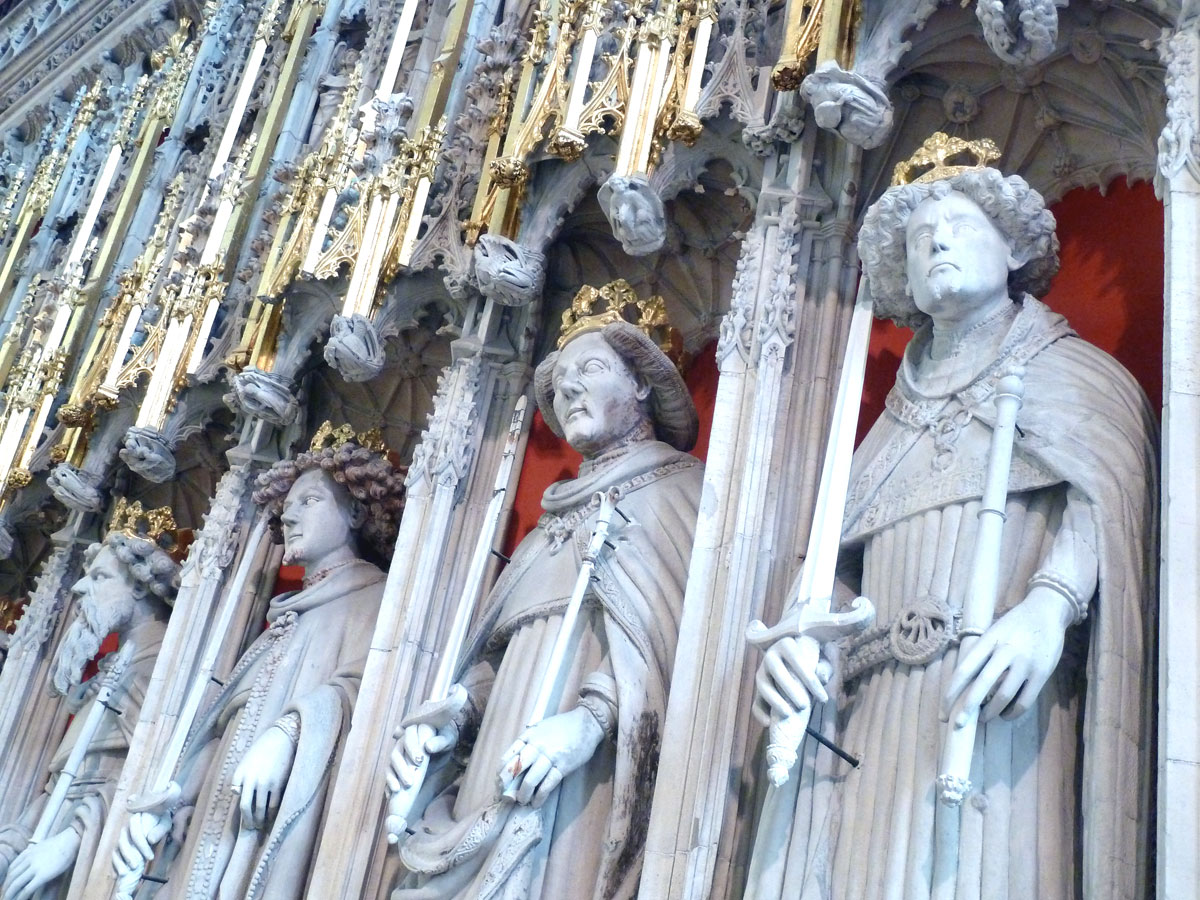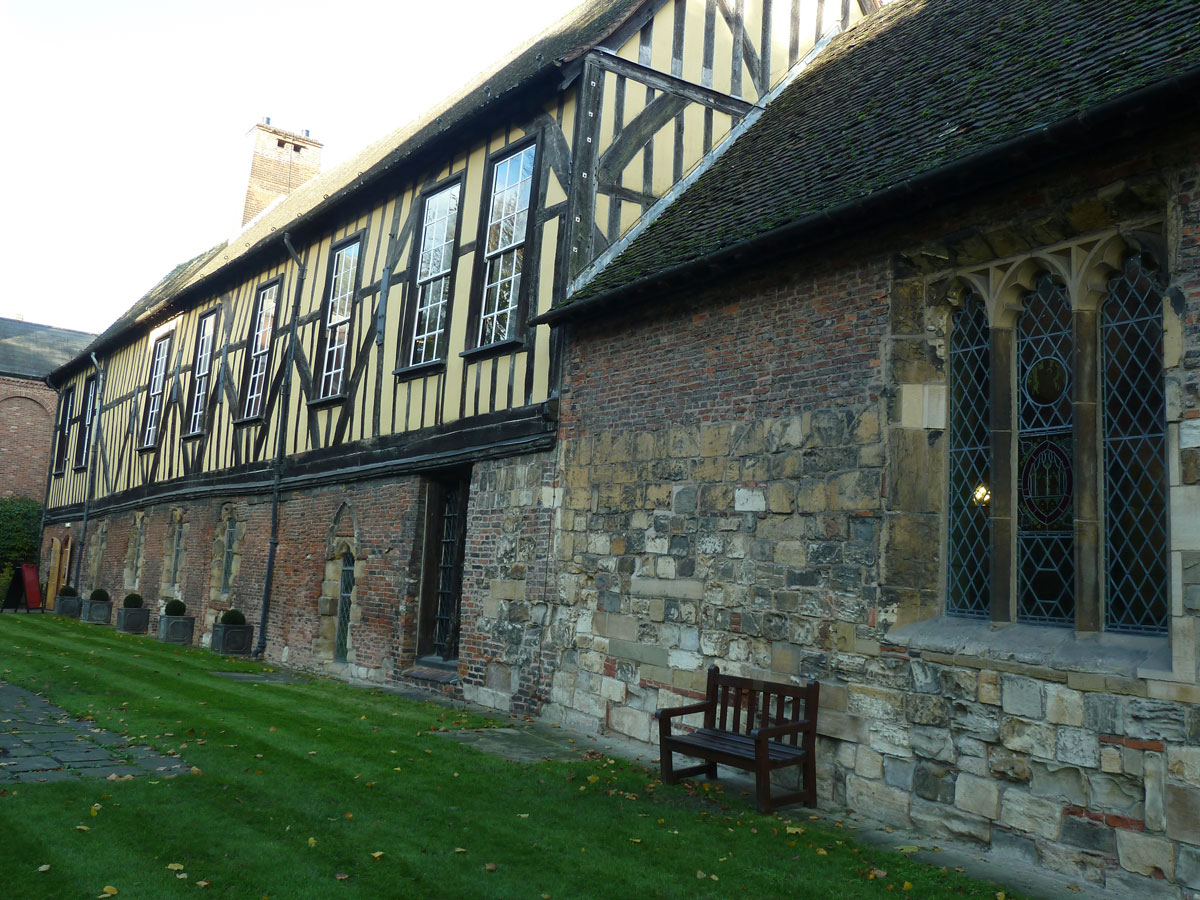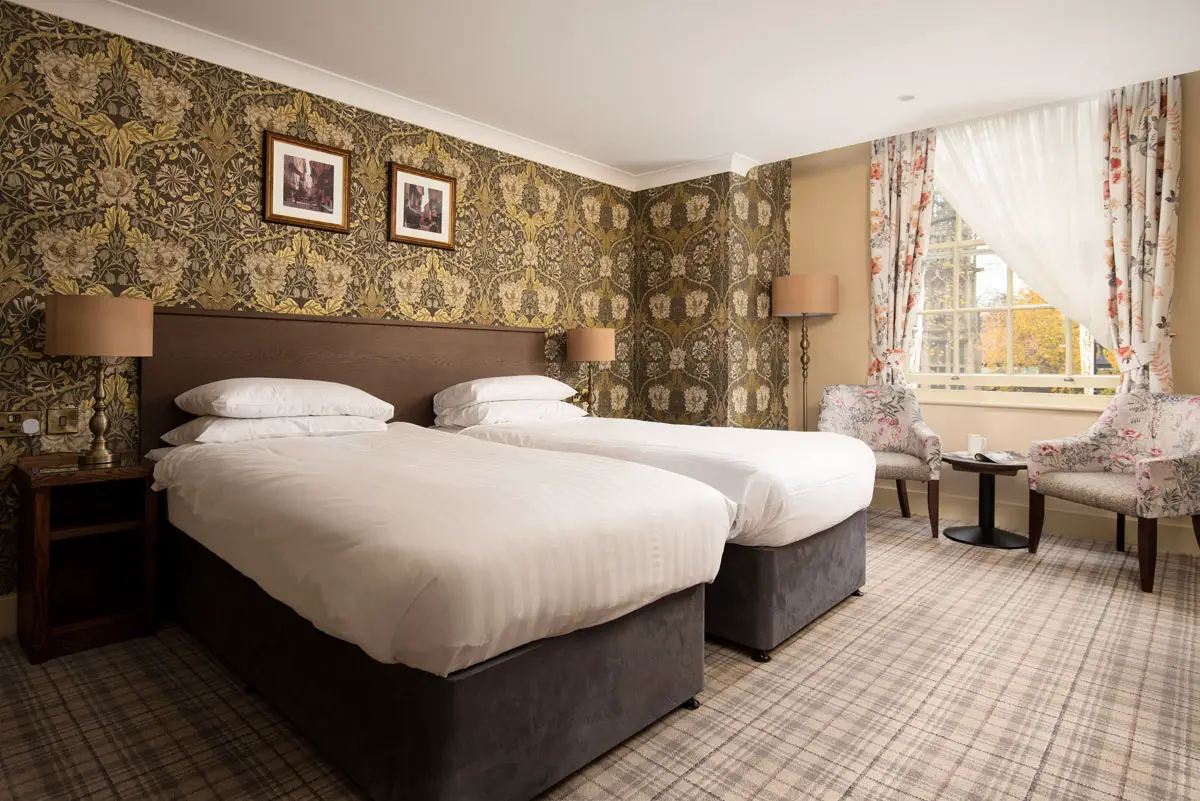York and Dean Court Hotel – Review
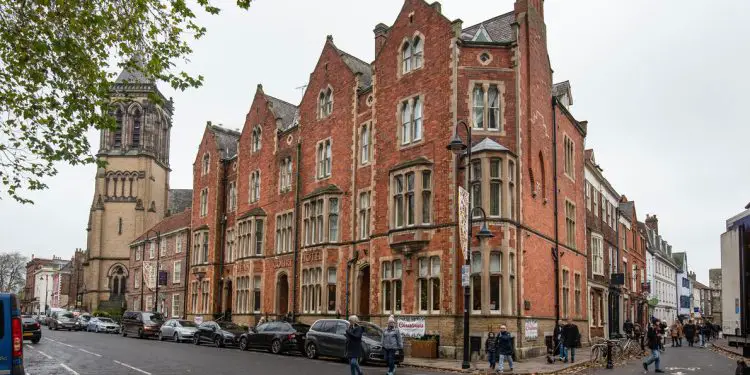
By Clare Jenkins, December 2023
There are two sides to York (well, OK, there are many sides to York but bear with me). There’s the ghost-seeking, Harry Potter-loving side, where you can down a ‘Hypnomeister’ at the Evil Eye cocktail bar, a ‘Tears of the Wizard’ cream soda at The Potions Cauldron or some beer, pie’n’peas at the Trembling Madness ‘medieval alehouse’. Afterwards, you can stagger through the streets to buy a ‘witches familiar’ from The Society of Alchemists, or a wand bracelet from The Shop That Must Not Be Named.
Then there’s the ‘far from the madding crowd’ side. This involves churches, convents, merchants’ townhouses, shrines – and the withered hand of a saint. And that’s the side my husband and I have come to see – not least because Steve studied English and Medieval French here many years ago. We can’t move in our house for Chretien de Troyes and The Lais of Marie de France.
I’ve brought with me Ian Mortimer’s fascinating book, The Time Traveller’s Guide to Medieval England. “It is the cathedral which you will see first,” he writes (of Exeter but, as he says, it fits York just as well). “There it is, massive and magnificent… It is hundreds of times bigger than every other building around it and dwarfs the stone walls which surround the city. The hundreds of houses appear tiny, all at chaotic angles, and of different shades and hues… The thirty churches… seem humble by comparison.”
A few pages later, Mortimer describes “the blackened heads of criminals stuck on poles above the city gates, their eyes plucked out by birds.” Thankfully, they’re long cancelled, but it doesn’t take much to veer off the heavily-beaten track (The Shambles, Stonegate, Parliament Street, High and Low Petergate) and into a more medieval and Tudor city.
“Lovely place”
First, though, on a glorious autumn day, we check in at the 40-bedroom Dean Court Hotel, a welcoming and reassuringly traditional place with Christmas baubles adding splashes of colour to the neutral décor (there are also some individual touches, like the stack of mock suitcases in reception, and some carved gargoyle wallpaper).
As for its position: you couldn’t get any closer to the Minster if you tried. From our spacious front-facing room, we could probably lean out of the window and touch it, if we had an archbishop’s crosier to hand.
We’ll explore the Minster later. First, we’re heading for smaller churches, starting with the 13th Century Holy Trinity, Goodramgate. Down Hornpit Lane, it’s tucked away in a corner among graves and trees and the backs of shops. Early afternoon, it’s wonderfully atmospheric with its lighted candelabra, medieval stained glass and dark-wood box pews. Outside is a plaque to Anne Lister of Gentleman Jack fame, who “took sacrament here to seal her union with Ann Walker”.
We brave the shoppers in Stonegate to pay our respects at the shrine of St Margaret Clitherow. This Catholic wife and mother, “The Pearl of York”, was literally pressed to death in 1586 for giving sanctuary to fellow Catholics. The shrine is a lovely place, its silence broken only by the sounds of people jostling and laughing in the street outside – sounds Margaret herself would have heard 450 years ago. It really isn’t hard to escape the hubbub of the city.
“Atmosphere”
Unbelievably, when we emerge, the queue outside Betty’s tearooms is considerably shorter than that outside York Ghost Merchants (another tourist-sucker). So we soak up the atmosphere of Viennese refinement from our corner table: floor to ceiling windows (all the better to people-watch), leaf-dappled glass, golden lighting and walls of mirrors. Served by waitresses in neat black skirts, high-necked blouses and white pinnies, we drink Golden Valley Darjeeling tea and eat heavenly (we’re still feeling spiritual) warm rarebit scones and sultana teacakes.
On the way back to the Dean Court, Steve gets distracted by the window of Clarkson’s classy menswear shop in Petergate, with its Harris tweed satchels, felt fedoras – and a green cord suit he ends up buying. So that’s us firmly back in the material world.
The hotel restaurant is quiet for a Thursday night, apart from the 1980s rock music. Our corner table again gives us the chance to spy on passersby (including crocodiles of English language students on Ghost/Shadows/Horror/Dark Chronicles walking tours), while eating delicious kale, lemon and ginger soup (me) and warm beets salad (Steve), followed by creamy cauliflower curry, and a rather hefty vegetable shepherd’s pie. The mixed green veg (kale, beans and mange tout) side dish rescues the latter, as does the lemon sorbet dessert – and the friendly, down-to-earth staff.
“Awe-inspiring”
The next morning, it’s time to enter the view from our room. The Minster, “the largest Gothic cathedral in Europe” and containing acres of medieval stained glass, is vast, an awe-inspiring cavern of a place.
The Great East Window is, of course, a main attraction, with its 311 panels: “a colourful cliff face of stained glass”, as it’s been described. Another, much smaller one (there are 128 windows in all) is rather sniffily inscribed ‘This window (1310) was indifferently restored (1789) and brought back as far as possible to its first state (1950)’.
A row of carved kings gurn down from the great choir screen – a poorly-looking William the Conqueror, a gormless William Rufus, three wild-haired Edwards. And there are numerous tombs of archbishops with fine whiskers and voluminous episcopal robes. You could spend a week exploring the place and still not take it all in.
Minstered out, it’s time for the sightseeing bus tour, an excellent way of not just seeing the city but also getting a sense of context. Ours combines the old and new: York St John University, the wide expanse of the racecourse, a Roman Gladiator burial site, ‘the largest collection of Jewish graves outside London’, dating from the 12th Century and Dick Turpin’s solitary grave (he was born and hanged here), plus some uninspiring modern estates.
“Clawed relic”
We get off near the Merchant Adventurers’ Hall, Britain’s oldest surviving half-timbered guildhall. Across the road from the utilitarian Primark, Topshop and a multi-storey car park, it’s another medieval delight. Used as a hospital and alms-houses from 1373 until 1900, it was built as a meeting-place for merchants trading throughout Europe, and has an appealing, back-in-time feel to it, with sloping floors, oak beams and furniture, a 16th Century chimney piece and magnificent 14th Century Great Hall. Treasures include a case of silverware including a death’s-head spoon, a skull engraving, and an ostrich egg-shaped biscuit barrel. Plus a very browsable shop and an excellent café.
Another perspective of the city is, of course, from the walls themselves – the best-preserved medieval walls in the country (cue Ian Mortimer again and his maggot-ridden bodies hanging by the gates). From Micklegate Bar, you can visit the Bar Convent, to lunch in its light and airy glass-roofed café, stroll round its Secret Garden, follow the story of its founder Mary Ward and check out the priest’s hole in the 18th Century chapel, one of the earliest Roman Catholic chapels to be built after the Reformation. It’s here that you’ll also find the withered hand of Margaret Clitherow, a tiny, clawed relic reaching out across the centuries.
We brave the traffic again to continue our bus tour, with its onboard commentary about York Dungeon’s ‘curse of the witch’, St Mary’s Abbey ruins, St George’s churchyard, the Calvary Chapel, and Bishopsthorpe Road, which The Times apparently named one of the “coolest” places to live in the UK.
“Restored”
Back in the hotel, Steve has the cauliflower curry again, while – veggie options being limited – I go for fish and chips. It’s pleasant, if unmemorable – though a woman at the next table in cream bodycon dress and Meghan Markle heels gushes: “That meal was absolutely to DIE for!”
The next morning, we visit the attractive, imaginatively restored Barley Hall, “a rare surviving example of a medieval townhouse”, built for a wealthy York merchant and city Mayor and tucked away down a ginnel. Its Shakespeariana exhibition includes Helena Bonham Carter’s dress from a 1996 production of Twelfth Night and Kate Winslett’s Ophelia dress from that same year.
Finally, on our way back to the station, we rest in the quiet of All Saints Church in North Street. Its stunning 14th Century Pricke of Conscience window shows the “events of the last 15 days of the world”. They include graves opening, fish roaring as sea levels fall and burn, bleeding trees, earthquakes and traumatised people hiding in caves. The final panels show “the death of all living things” and “the end of the world, consumed by fire”.
And we wonder: is it too late to go back to the Minster and pray for miracles?
The Dean Court Hotel, Duncombe Place, York YO1 7EF, tel: 01904-376315
Rooms in low season are from £107.10 per night (advanced purchase, non-refundable) and £119.00 per night (pay on arrival, free cancellation up to 48hrs prior) www.inncollectiongroup.com/dean-court
https://yorkminster.org
Events | yorkvenues.org.uk, whats-on-yorkshire.com
The Visit York Pass covers 25 attractions, including the Bar Convent, Barley Hall, Castle Museum, City Sightseeing bus tours, Merchant Adventurers’ Hall, Minster, National Railway Museum – https://yorkpass.com/
